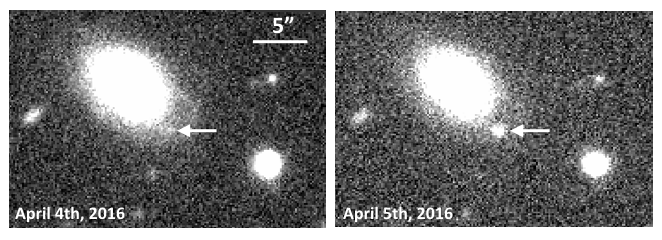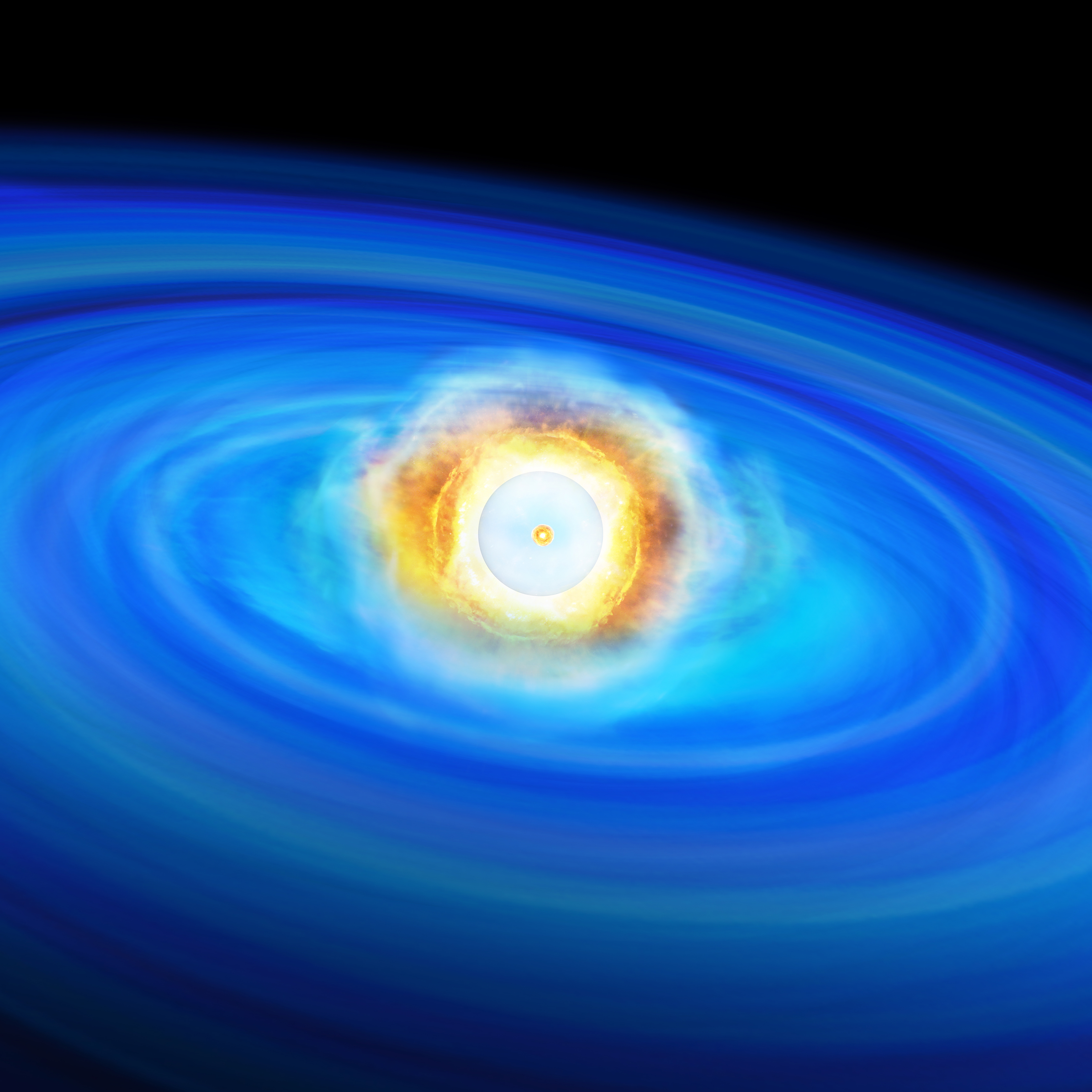An international team of researchers has found evidence that the brightest stellar explosions in our Universe could be triggered by helium nuclear detonation near the surface of a white dwarf star. Using Hyper Suprime-Cam mounted on the Subaru Telescope, the team detected a type Ia supernova within a day after the explosion, and explained its behavior through a model calculated using the supercomputer ATERUI. This result was reported in Nature published on Oct. 5.

Figure: A type Ia supernova detected within a day after exploding. Taken with Hyper Suprime-Cam
mounted on the Subaru Telescope. (Credit: The University of Tokyo / NAOJ)

Illustration: Artist’s impression of the supernova explosion. The nuclear detonation of the surface helium layer
triggered an inward shock wave, and now carbon nuclear fusion has begun at the center.
Credit: Institute of Astronomy, The University of Tokyo
Please see the full story: "Surface Helium Detonation Spells End for White Dwarf" (Subaru Telescope Press Release).
A member of this research team, Masaomi Tanaka (CfCA, NAOJ / SOKENDAI) made the following comments:
Our research team led by Ji-an Jiang and Professor Mamoru Doi successfully caught the first day of a Type Ia supernova explosion with a high-cadence survey thanks to the wide field-of-view of Hyper Suprime-Cam. The spectra of this object show mysterious features, which are quite different from those of other supernovae. Numerical simulations performed by Professor Keiichi Maeda using the supercomputer "ATERUI" unveiled the nature of this phenomenon. I am happy that we have revealed the explosion mechanism of type Ia supernovae through a synergy between the Subaru Telescope and ATERUI in collaboration with many researchers.
Paper Details
Title: A hybrid type la supernova with an early flash triggered by helium-shell detonation
Authors: Ji-an Jiang, Mamoru Doi, Keiichi Maeda, Toshikazu Shigeyama, Ken’ichi Nomoto, Naoki Yasuda, Saurabh W. Jha, Masaomi Tanaka, Tomoki Morokuma, Nozomu Tominaga, Željko Ivezić, P. Ruiz-Lapuente, M.D. Stritzinger, P.A. Mazzali, Christopher Ashall, Jeremy Mould, D. Baade, Nao Suzuki, Andrew J. Connolly, F. Patat, Lifan Wang, Peter Yoachim, David Jones, Hisanori Furusawa, Satoshi Miyazaki
Journal: Nature
DOI: 10.1038/nature23908
This research was supported by JSPS Grant-in-Aid 16H01087, 26287029, 26800100, 17H02864, 6H06341, 16K05287, 15H02082, 26400222, 16H02168, 17K05382.
In addition, the following grants supported this research;
- The World Premier International Research Center Initiative (WPI Initiative), MEXT, Japan The research grant program of the Toyota foundation (D11-R-0830).
- The support from the US National Science Foundation through award AST-1615455 The research grant (13261) from VILLUM FONDEN.
Supercomputer used in this work
 The supercomputer “ATERUI” (Cray XC30) is a massively parallel supercomputer for astrophysical simulations. Its theoretical peak performance is 1.058 Pflops, making it the world’s fastest supercomputer dedicated to astronomical simulation. Since the installation of ATERUI at NAOJ Mizusawa Campus in 2013, approximately 140 users have used this system every year. (Image Credit: NAOJ)
The supercomputer “ATERUI” (Cray XC30) is a massively parallel supercomputer for astrophysical simulations. Its theoretical peak performance is 1.058 Pflops, making it the world’s fastest supercomputer dedicated to astronomical simulation. Since the installation of ATERUI at NAOJ Mizusawa Campus in 2013, approximately 140 users have used this system every year. (Image Credit: NAOJ)
For the use of contents in this website
- Contents are to be used with a clear indication of its copyright (e.g. (c) NAOJ.)
- If you would like to use the contents found in this web site, please follow Terms of Use of the Website of NAOJ.
Related Links
Press Release: "Surface Helium Detonation Spells End for White Dwarf" (Subaru Telescope)
Press Release: "Surface Helium Detonation Spells End for White Dwarf" (Kavli IPMU, The University of Tokyo)
Press Release: "Surface Helium Detonation Spells End for White Dwarf" (The University of Tokyo)
Press Release: "The star that burns twice as bright" (Kyoto University)
